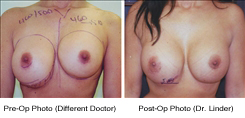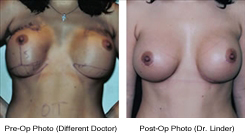Bottoming Out, Beverly Hills Revision Surgery
Posted On: June 01, 2010 Author: The Office of Dr. Stuart Linder Posted In: Breast Revision
Patients present to Dr. Linder every week for revision surgery. This is one of his fortes. Breast revision surgery requires experience, judgment and talent and many years of experience in performing augmentation mammoplasty as well as breast lifts, breast reductions and breast enhancement surgeries. Combining all of that general knowledge will increase your chances of having successful secondary or revision surgery.

Bottoming out occurs when the implant gravitationally descends, lowering in the pocket and the nipple elevates within the pocket. The nipple may actually end up on top of the breast which leads to a severe deformity referred to as “bottoming out.” This can occur due to the pocket technically being made too low and the inframammary fold ending up low on the chest well or due to with time patients not wearing supportive brassieres, including underwire bras during the day and sports bras at night or sleep bras which will help to maintain position. If you think about it, it is difficult for the inframammary fold to maintain a large, large implant and over time without support of the fold, the fold may lower and fall. Ways to impair it include internal capsulorrhaphies (tightening the capsule into itself), autologous dermal matrix, including AlloDerm and allographs, which can be quite expensive, as well as neo-pocket formation and autologous dermograph placement or a simple inframammary tightening procedure with an inframammary lift, removing the skin around the inframammary fold, which may elevate the fold and then tighten the lower breast, and recentralize the nipple areolar complex into the middle. (Please see the following example of a severe bottoming out.)

Bottoming out surgery can be very difficult to repair and therefore, it is most important during original surgery that the implants be placed through an approach which is simple, such as the periareolar approach, where the inframammary fold can be lowered absolutely as accurate as possible and not too much.